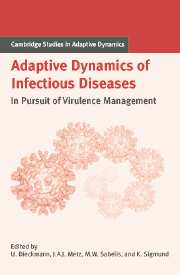Book contents
- Frontmatter
- Contents
- Contributing Authors
- List of Boxes
- Notational Standards
- 1 Introduction
- A Setting the Stage
- B Host Population Structure
- C Within-Host Interactions
- D Pathogen–Host Coevolution
- Introduction to Part D
- 13 Coevolution of Virus and Host Cell-death Signals
- 14 Biogeographical Perspectives on Arms Races
- 15 Major Histocompatibility Complex: Polymorphism from Coevolution
- 16 Virulence Management and Disease Resistance in Diploid Hosts
- 17 Coevolution in Gene-for-gene Systems
- 18 Implications of Sexual Selection for Virulence Management
- 19 Molecular Phylogenies and Virulence Evolution
- E Multilevel Selection
- F Vaccines and Drugs
- G Perspectives for Virulence Management
- References
- Index
- International Institute for Applied Systems Analysis
Introduction to Part D
Published online by Cambridge University Press: 15 January 2010
- Frontmatter
- Contents
- Contributing Authors
- List of Boxes
- Notational Standards
- 1 Introduction
- A Setting the Stage
- B Host Population Structure
- C Within-Host Interactions
- D Pathogen–Host Coevolution
- Introduction to Part D
- 13 Coevolution of Virus and Host Cell-death Signals
- 14 Biogeographical Perspectives on Arms Races
- 15 Major Histocompatibility Complex: Polymorphism from Coevolution
- 16 Virulence Management and Disease Resistance in Diploid Hosts
- 17 Coevolution in Gene-for-gene Systems
- 18 Implications of Sexual Selection for Virulence Management
- 19 Molecular Phylogenies and Virulence Evolution
- E Multilevel Selection
- F Vaccines and Drugs
- G Perspectives for Virulence Management
- References
- Index
- International Institute for Applied Systems Analysis
Summary
Virulence is not a property of the parasite, but of the interaction between host and parasite. Accordingly, the evolution of virulence is the result of a coevolutionary process and to understand it we have to account for both sides. As a result of their generation time, which is usually much shorter than that of the host, microparasites seem to be at a huge advantage. However, sexual reproduction allows host organisms to present a moving target (while at the same time inevitably offering opportunities for parasites to use sexual contacts between hosts to infect new susceptibles). In particular, genetic recombination helps to preserve heterozygosity and leads to a wide diversity of immune responses. But there are many other examples of the intricate struggles between parasite and host and of the trade-offs imposed on them.
Part D explores how reciprocal selection between host and parasite populations influences the evolution of host resistance and parasite virulence. Chapters 13 and 14 deal with parasite–host interactions in which investments in resistance and/or virulence incur a cost. The question here is how the resultant trade-offs influence the coevolutionary process. In Chapters 15 to 17 trade-offs play no role. In these, coevolution acts on the ability of the host to recognize the parasite and discriminate it against cells and tissue of its own, while, at the same time, parasites attempt to bypass recognition by the host. In its simplest form this leads to gene-for-gene coevolution.
- Type
- Chapter
- Information
- Adaptive Dynamics of Infectious DiseasesIn Pursuit of Virulence Management, pp. 180 - 182Publisher: Cambridge University PressPrint publication year: 2002

